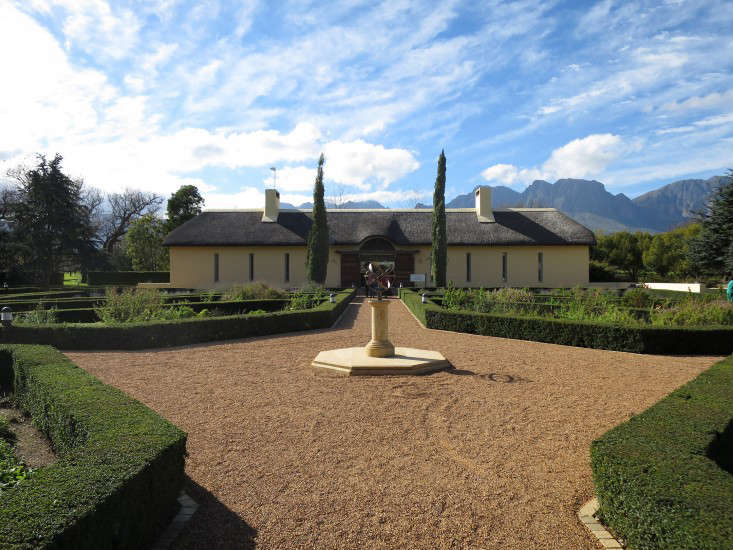There is a good thing about Cape Town in winter. You can still visit gardens. One of those gardens is at Vergelegen. Dutch for “situated far away,” the famous wine estate at the foot of the Helderberg, east of Cape Town, used to be a long wagon ride from that port city. Now, it’s a half hour drive on a multiple lane freeway.
Photography by Marie Viljoen for Gardenista.
Above: The Cape’s cold season has two kinds of days: wet, and perfect. While wind and rain tear the southern tip of Africa apart from June through August, they also turn it deeply green. And when the skies clear, immaculate blue spells reveals the folds and spines of the mountains on every horizon, and the structure of the best gardens, with a clarity never seen in summer.
Above: Established by Dutch governor Willem Adriaan van der Stel in 1700, Vergelegen’s gardening pedigree is long. Five massive camphor trees and an oak which were planted at that time still preside over the oldest gardens. Now owned by the Anglo American mining company, Vergelegen produces some of South Africa’s best wines, and it is also home to an arresting series of 18 self-contained and evolving gardens set amid stunning scenery. I visited recently.
Above: The two newest additions to the estate’s garden scheme were designed and implemented in 2011. The first is beside the airy wine tasting center–a formal herb and vegetable garden, laid out with neatly pruned small-leafed privet surrounding kitchen garden plantings.
Above: Vergelegen’s head horticulturist and garden manager Richard Arm, who has worked at the estate since 2010, helped lay out this garden. Mr. Arm explained: “All transplanting from the old herb garden had to be done during winter. We started with the new layout in August, almost too late… The privet hedges transplanted beautifully–straight lines and levels. The octagonal shape is an integral part of the history of Vergelegen.”
Above: The herb garden is centered by a sundial in the middle of the crunching gravel walkways and flanked by the handsomely thatched wine tasting center and the Stables Bistro. The low, angular hedges create a sense of intimacy beyond which the wild landscape of the towering Hottentots Holland mountain range fills the horizon.
Above: Within the strict confines of the hedges is a tangled collection of herbs. In one segment of the octagon are traditional southern African medicinal plants, including deeply aromatic buchu, aloes in bright bloom, bulbine, wild ginger, wild garlic, cancer bush, wild dagga, and wild geranium.
Above: Aromatics feature strongly, with lavender providing gray and feathery relief from the dark, rigid privet. Elsewhere are exotic medicinal plants as well as culinary herbs for the estate’s chefs. Lemon grass and hot red chiles hug each other in a bed that speaks of Southeast Asia. The central quadrants are devoted to edible flowers, a strong feature in spring and summer. Mr. Arm explained that only organic compost and fertilizers are used in the kitchen garden.
Above: I wondered about garden pests. Patrols of voracious Egyptian geese march across the grounds, and what about slugs? The answer was unexpected: “…it’s the peacocks eating my heirloom vegetables and herbs that cause me more grief,” said Mr. Arm, whose staff of 11 gardeners is also on peacock patrol. “Earlier this season we planted beautiful little violas in half wine barrels at our Stables restaurant–the peacocks had a field day eating these edible flowers up. We now use bird netting to protect our young seedlings.”
Above: On the mountain-side of the Stables is the second new garden: the extensive East Garden was designed by Cape Town-based landscape architects OvP Associates. The symmetrical beds in summer provide a showstopping display of 14,000 agapanthus (21 cultivars) in full bloom. When I visited, the bones of this formal garden were beautifully laid bare in the backdrop of blue mountains, bare oak trees, espaliered fruit hedges, and pretty blue indigenous felicia in bloom beside the straight paths and their central watercourse.
Above: Wandering away from these modern gardens down a tree-lined avenue, one passes wintery parkland plantings before turning towards the old manor house, its first glimpse framed by the old garden wall, and reached by a long path flanked by perennial beds.
Above: Beyond the grand old home’s cool interior preside the enormous 300-year-old camphors and a wide lawn, dotted now with pink oxalis, indigenous volunteers which speak inadvertently to the estate’s commitment to biodiversity (2,000 hectares of former plantation monoculture have been restored to endemic fynbos). Here is a famous camellia collection, 1,000 specimens strong, and a wild, wetland garden, which skirts the Lourensford River, rushing with winter rains.
Above: Flanking the manor house are the formal and older gardens where cypress planted by Lady Florence Phillips in the 1920s still tower above the Cape Dutch gables of the outlying buildings. The wife of the mining magnate Sir Lionel Philips, who presented the estate to his wife as a gift, Lady Phillips is credited, from 1917 to her death in 1941, with restoring and reviving–with her husband’s fortune–much of the then derelict garden. The octagon garden layout upon which the modern gardens are modeled, is her instigation.
And this is the winter garden, the off season, apart from those camellias in bloom. I look forward to returning in summer to see the sea of agapanthus, the blue hydrangea garden, and the 18-bed rose garden. I’d like to picnic in the camphor forest (“fancy picnics,” clarifies Mr Arm, “with neat tables and white linen, waiters and ice buckets…”). I would not mind buying another case of that killer Vergelegen Shiraz.
And perhaps I could pull a peacock’s tail.
(With special thanks to Richard Arm, read more about him at 66 Square Feet.)
For more from Cape Town, see My Mother’s Garden in South Africa and, on Remodelista: Stripped Down in Cape Town: Clarke’s Bar and Dining Room.
























Have a Question or Comment About This Post?
Join the conversation (2)